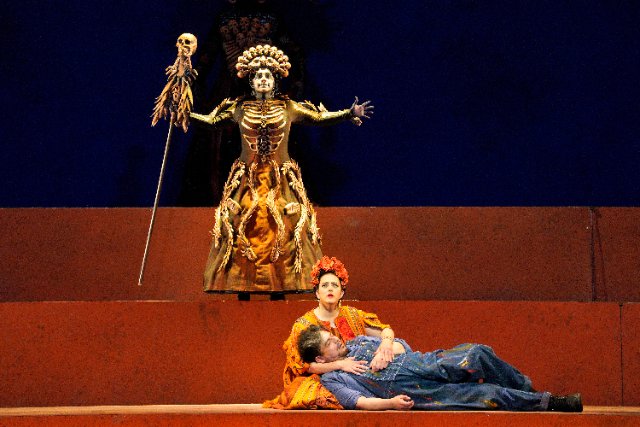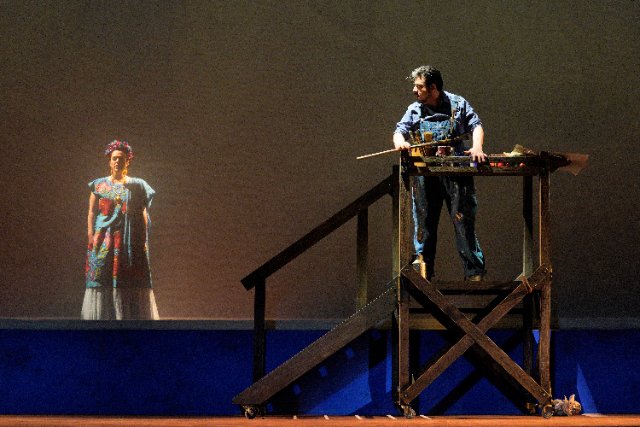El Último Sueño de Frida y Diego
Two Modern Artists Fictionalized in an Opera with an Orpheus-like Story.
By: Victor Cordell - Jun 15, 2023
In North America, no artistic couple has ever been as noted or as iconic as Mexican painters Diego Rivera and Frida Kahlo – he for his large-scale, socio-political murals and she especially for her self-portraits in a magical realism style. San Francisco was significant for the couple. Among other connections, they lived here briefly in the early ‘30s, and having divorced in 1939, were remarried in 1940 at City Hall, across the street from War Memorial Opera House. So, it is fitting that San Francisco Opera would co-produce a work to honor the two. This represents the first time in its 100 years that the company has commissioned a work by a female composer or performed one sung in Spanish. The result is visually stunning and musically powerful.
Composer Gabriela Lena Frank’s special compassion for Frida may derive from their shared experience. Both are Latinas of mixed blood; both have suffered debilitating medical conditions; and though their specialties differ, they are both involved in the arts. Argentine-born mezzo Daniela Mack performs Frida and what a fit. In this fantasy, Frida is deceased, and Mack’s deep, dark, heavy vibrato suits the condition and the music wonderfully. The role has an unusually low tessitura, constantly testing the bottom of Mack’s range, but she skillfully maneuvers through the score and appears as a totally convincing Frida.
Cuban-born, Pulitzer Prize winning (“Anna in the Tropics”) playwright Nilo Cruz provides the literate libretto. Wishing to integrate aspects of Mexican culture into the libretto in a magical realism fashion, he builds the narrative around the culturally significant Día de los Muertos (Day of the Dead) and Aztec mythology. He also introduces an element from literature, a twist on the Orpheus and Euridice story. The dying Diego, sung effectively by baritone Alfredo Daza who also looks and acts well in an underdeveloped role, yearns for Frida. She resists returning to the human world because of the mental anguish that Diego had caused her and the endless physical pain she suffered during her life. Ultimately, she does agree to return to the living to accompany his passage into the underworld. Frida is granted 24 hours on earth, but forbidden to touch a living being, at the price of reliving her physical pain.
The rule maker is Catrina, Keeper of the Dead, a harrowing skeletal figure played by Yaritza Véliz, a lyric soprano who adroitly attacks the dramatic singing demands of the role with zest. Although Véliz totally commands the stage, credit Costume Designer Eloise Kazan for Catrina’s striking look as well as the full array of remarkable costumery that enhances the production. The fourth main principal draws from outside of the central relationship. The character is Leonardo, a female impersonating actor with a Greta Garbo obsession, performed by outstanding countertenor, Jake Ingbar, who takes on an almost Queen of the Night coloratura aria with great agility and success. There is a thematic connection to this character’s being written into the narrative, but explaining it here wouldn’t be very productive.
The composer’s not uncommon modern approach combines lush musical brushstrokes as a foundation with tense, pointillistic finishing touches. Staccato punctuation to the harmonious undertones comes from everywhere in the orchestra from timpani and gong to strings and horns. Even the chorus contributes to the sometimes sharply unsettling strokes. Some subtle Mexican folk music themes enter the score and even a brief phrase of percussive trumpets that seems like it may lead to a mariachi song. The use of lyrical and dramatic singing yields an attractive balance of styles, but lacks memorable melody.
Día de los Muertos offers great scope for Jorge Ballina’s colorful and macabre scenery. In Act 1, naranja, or orange, está el color del día. Orange and yellow marigolds, along with an abundance of candles, skulls, and crosses bedeck the stage, arrayed and lit in a manner to create deep and layered visual perspective. Orange dominant costumery abounds in the chorus, adding to the striking look of the holiday. The contrast of detail and perspective in much of Act 2 could not be stronger, opening with park scenery depicted in muted colors and two-dimensions. Later, Diego’s studio is bereft of decoration – a mural-sized blank canvas and walls of endless blue representing Frida’s Casa Azul. Yet the costumes in group scenes in Act 2 display a flush palate of color. The overall visual effect in both acts captivates.
This production benefits from the continuity of having opened with the same design team at San Diego Opera, and Director Lorena Maza integrates their contributions seamlessly. Conductor Roberto Kalb reprises his involvement as well, ensuring a knowledgeable and skilled hand at the baton. Except for Daza, the four principals are new to their roles, but individually and collectively, their singing and acting is superb.
While its tone consistently buoys the opera, its weakest element lies in the storytelling. The pace at times can be like watching paint dry (to put it in the frame of the opera – and picture frames are one of the many appealing stage props). Somewhat related, the stakes do not seem considerable. Frida is already dead, and Diego is dying, so what consequences of their actions can be that bad? Happily, other aspects of the production far more than counterbalance these matters and make for a highly appealing opera.
“El Último Sueño de Frida y Diego,” composed by Gabriela Lena Frank with libretto by Nilo Cruz; is produced by San Francisco Opera; is commissioned by San Diego Opera, San Francisco Opera, Fort Worth Opera, DePauw University, and with support from University of Texas; and plays at War Memorial Opera House, 301 Van Ness Ave., San Francisco, CA through June 30, 2023.








